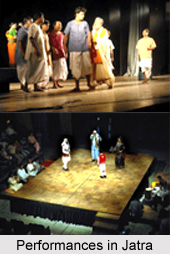 Jatra is a famous folk theatre from Bengali theatre that is spread throughout most of Bengali speaking states of India including West Bengal, Bihar, Assam, Orissa and Tripura. Lots of people, actors and actresses are involved in this form of art in West Bengal and other parts of India. Jatra is considered as a famous form of traditional folk theatre from the eastern region of India. It literally means a journey and hence, stylized delivery and exaggerated gestures and orations are some of features of Jatra.
Jatra is a famous folk theatre from Bengali theatre that is spread throughout most of Bengali speaking states of India including West Bengal, Bihar, Assam, Orissa and Tripura. Lots of people, actors and actresses are involved in this form of art in West Bengal and other parts of India. Jatra is considered as a famous form of traditional folk theatre from the eastern region of India. It literally means a journey and hence, stylized delivery and exaggerated gestures and orations are some of features of Jatra.Jatra is believed to have originated from ceremonial functions that are called before starting on a journey. There are also the other legends saying, that it developed from processions brought out in respect of different gods and goddesses. These processions often included songs and dances as its primary part. Jatra is a form of Indian folk drama combining acting, songs and music and dance altogether by the troop that is travelling from one place to another. In the earlier years, the religious values were well communicated with the help of Jatra to the masses. Jatra performances in West Bengal resemble the Tamasha of Maharashtra, the Nautanki of Uttar Pradesh and Bhavai Dance of Gujarat. Even if the birthplace of Jatra lies in religious landscapes, filled with different Bhakticults of Hinduism, but it is replaced by morally educative contents by the end of 19th century. As a result, during Bengal Renaissance, it gained entry into the urban theatres.
Various parts of Hindu epics like Mahabharata and Ramayana was also preformed. Later on, the Jatras were held beside palas, and sometimes even replacing it.
Origin of Jatra
The roots of Jatra may be traced back in at least the 16th century, in Bengal, where there was a famous form of singing called the Carya, which were characterized by the distinct use of language. This was a kind of musical drama, which was possibly prevalent during that time. Even Chaitanya (social reformer) and his followers contributed to a reawakening among the people and were responsible for bringing about a national integration in various parts of India at the cultural level, since Chaitanya himself played role of Rukmini in a drama. This drama was perhaps the beginning of the "Krishna Jatra". So he is respected as the predecessor of the contemporary Jatras of Bengal.
Development of Jatra
 Mukunda Das (1878-1934) and his troupe, the Swadeshi Jatra Party, performed Jatras and represented colonial exploitation, patriotism and anti-colonial struggle, oppression of feudal and caste system etc through Jatra. During the 1940s, the socio-political content of Jatra superseded the religious-mythical theme. Apart from theme, major change that took place around this time was in the induction of actresses to enact female roles in the play. But the incident of Partition of India however, seems to have adversely affected Jatra as most of performances were performed related with historical plays, with a vague sense of nationalism and patriotism, or melodramatic social plays. Particularly popular during this period, especially in the southern district of Barisal, was Gunai Jatra. Gunai Jatra was based on the tale of a village maiden named Gunai Bibi. The tradition of religious tales continued, in the form of Bhasan Jatra and Krishna Jatra, both of which were dominated by songs and music in terms of its content.
Mukunda Das (1878-1934) and his troupe, the Swadeshi Jatra Party, performed Jatras and represented colonial exploitation, patriotism and anti-colonial struggle, oppression of feudal and caste system etc through Jatra. During the 1940s, the socio-political content of Jatra superseded the religious-mythical theme. Apart from theme, major change that took place around this time was in the induction of actresses to enact female roles in the play. But the incident of Partition of India however, seems to have adversely affected Jatra as most of performances were performed related with historical plays, with a vague sense of nationalism and patriotism, or melodramatic social plays. Particularly popular during this period, especially in the southern district of Barisal, was Gunai Jatra. Gunai Jatra was based on the tale of a village maiden named Gunai Bibi. The tradition of religious tales continued, in the form of Bhasan Jatra and Krishna Jatra, both of which were dominated by songs and music in terms of its content.For more, visit the link below: